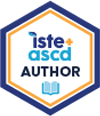
Event Information

**Welcome and presenter introductions; introduction of the backchannel discussion presenters will use to collect audience questions and interact during the session. - 2 minutes
**Description of the educational context in which presenters work (i.e. student and community demographics, needs, barriers, etc.) Identifying the challenge: Accelerating instruction while helping students build literacy skills to reach grade-level proficiency in the post-pandemic classroom. - 3 minutes
**Presenters will use Mentimeter to poll attendees regarding their perception of barriers that students face when asked to read and comprehend text. Presenters will discuss audience responses as they generate a word cloud. Brief explanation of how results reflect the need for Universal Design for Learning (UDL) and how AI-powered image generation can aid in personalized learning. - 5 minutes
**Explanation of the benefits of creating a classroom that offers instruction through a lens of creativity. Showcase of durable skills that develop as students engage with content and build literacy in an environment that includes creative tools and tasks. - 5 minutes
**Presenters showcase several replicable literacy strategies and activities that involve AI-powered image generation. Presenters will share project templates and additional resources that attendees can implement immediately in the classrooms they serve. This section includes a plethora of samples created by students. - 30 minutes
The above section includes the following:
---Visual Thinking (annotating text, using annotations to prompt AI for image generation)
---Digital Storytelling with AI-generated images
---Primary Source breakdown using AI-generated images
---Creating identity graphics for character analysis using AI image generation
---Creating AI-generated animation based on student voice recordings to summarize text and make connections
Participant interaction in this section includes:
---The selection of an AI-powered image generators to utilize for experimental prompting
---Hands-on experimentation with either Adobe Animate from Audio (for AI-powered voice recording) or a Diffit Visual Summary sample (to break down complex text) in conjunction with an AI image generator of choice.
** Presenters will discuss best practices for teaching students to create and use AI-generated images. - 5 minutes
This section includes but is not limited to the following:
---Appropriate use of AI-powered tools for image generation
---Effective prompting for AI based on textual details
---Ethics of image generation and selecting ethical image generators to use
**Attendees will also participate by adding their own ideas to a collaborative Padlet. The focus of the Padlet is how AI-powered image generators could support the literacy development of the students they serve. - 5 minutes
**Closing, questions from the backchannel, and additional resources. - 5 minutes
**Please note: Some of these research articles/books pertain to the concept of digital storytelling. Storytelling using images is relevant to this session because the focus is the use of generative AI images for the purpose of literacy skill building.
Pack, J. (2024, April 1). Using AI to enhance universal design for learning. Edutopia. https://www.edutopia.org/article/using-ai-in-universal-design-for-learning
Pack, J. (2021). Moviemaking in the Classroom: Lifting Student Voices Through Digital Storytelling.
Pack, J. and Terlaje, G. (2023). Storytelling Saves the World on Apple Podcasts. https://podcasts.apple.com/us/podcast/storytelling-saves-the-world/id1480027684.
Bernard, R. (2016, December). The power of digital storytelling to support teaching and learning - ed. https://files.eric.ed.gov/fulltext/EJ1125504.pdf
Gallo, C. (2019). Storytelling to Inspire, Educate, and Engage. American Journal of Health Promotion, 33(3), 469–472. https://doi.org/10.1177/0890117119825525b
Hellerich, K. (2021, September 8). An exercise in digital storytelling. Edutopia. https://www.edutopia.org/article/exercise-digital-storytelling
Leonard, D. (2023, October 30). 9 tips for using AI for learning (and fun!). Edutopia. https://www.edutopia.org/article/using-ai-for-learning-fun
Miller, M. (2023, January 18). AI image generators: The new frontier in education. Ditch That Textbook. https://ditchthattextbook.com/ai-image-generators/
Paparone, R. (2024, March 19). Using AI image generators in world language classes. Edutopia. https://www.edutopia.org/article/using-ai-image-generators-world-language-classes
Peterson, L. (2018, October 17). The Science Behind The Art Of Storytelling. Harvard Business Publishing: Corporate Learning. https://www.harvardbusiness.org/the-science-behind-the-art-of-storytelling/.
Vu, V., Warschauer, M., & Yim, S. (2019). Digital Storytelling: A District Initiative for Academic Literacy Improvement. Journal of Adolescent & Adult Literacy, 63(3), 257-267. https://doi.org/10.1002/jaal.962
Warner, B. (2024, January 17). 5 ways to use AI-generated images in your classroom. TESOL International Association. https://www.tesol.org/blog/posts/5-ways-to-use-ai-generated-images-in-your-classroom/
Zak, P. J. (2013, December 13). How Stories Change the Brain. Greater Good Magazine. https://greatergood.berkeley.edu/article/item/how_stories_change_brain.


